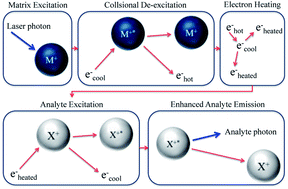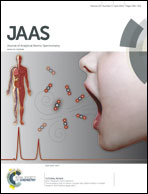A novel approach to understanding the effect of matrix composition on analyte emission in an inductively coupled plasma
Abstract
Pulsed laser radiation was directed at an inductively coupled plasma containing a high concentration of an alkaline earth matrix and a lower concentration of a test analyte. When the laser was tuned to an ionic resonance line of the matrix there was a universal transient enhancement of emission lines from the test analyte, irrespective of its identity. The effect was observed for Mg, Sr, Ba, Y, and Zn analytes in the presence of Mg, Sr, and Ca matrices. The enhancement is attributed to heating of the electrons in the plasma by superelastic collisions between electrons and excited matrix ions. By analogy to the laser-based experiments, a model is proposed for plasma-based matrix effects in the ICP, in which energy lost in the form of radiation from matrix ions cools the plasma, resulting in reduced emission from analyte species. The magnitudes of the radiative losses for 0.05 M Ca and Ba matrices were calculated to be 8.7 W cm−3 and 8.3 W cm−3, respectively. The model accounts for observed differences between group I and group II matrices.


 Please wait while we load your content...
Please wait while we load your content...